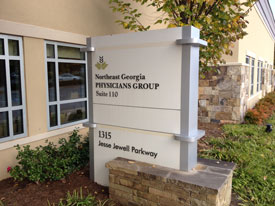Population Health Management Proves HIT's Worth

By Ken Congdon
By leveraging data analytics technology to gain insight into its patient population, Northeast Georgia Physicians Group has decreased the A1C levels of its diabetic patients by 1.6 points and significantly reduced ER visits.
A lot of healthcare providers question the value of IT. They don’t yet see the rewards that the digital transformation of health data can deliver. To these providers, the adoption of EHRs and supporting technologies are just a time consuming and costly exercise with little immediate upside for their organizations and its patients. Where is the evidence that health IT can cut costs and improve patient care? They ask. Northeast Georgia Physicians Group (NGPG), a multispecialty group with more than 180 physicians, has the proof these skeptics demand. For NGPG, the transition to EHR technology was a necessary step to digitize and standardize patient data. It provides the foundation for data aggregation and automation. Population health management technology, on the other hand, is where the rubber meets the road. These data analytic tools scour the electronic data that resides in an EHR (or across several disparate EHRs) to uncover critical trends within patient populations — trends that health providers can act upon. NGPG, for example, has used the data intelligence provided by a population health management solution to make a significant impact on patient and business outcomes.
NGPG is a long-time user of EHR technology, implementing the Allscripts Enterprise platform way back in 2006. Today, the physicians group is 100% paperless from a charting perspective. However, it wasn’t until early 2012, when it was awarded a TranforMED grant from The Center for Medicare and Medicaid Innovation (CMMI) that it started experimenting with population health management technology. The grant was awarded to NGPG to help fund its transition to a Patient-Centered Medical Home (PCMH) and centered-around utilization of the Phytel Outreach population management toolset. Phytel Outreach combines an electronic patient registry with automated messaging to identify trends or care gaps and send the appropriate alerts to providers and patients.
DIABETICS PROVIDE PERFECT TEST BED FOR POPULATION HEALTH MANAGEMENT
NGPG decided to pilot the Phytel technology with its diabetic patients. It used the analytic toolset to target uncontrolled diabetic patients within its population (patients with an A1C measurement above 8). According to the American Diabetes Association (ADA), health providers should strive to keep the A1C measurement of diabetic patients below 7 to avoid diabetic complications (e.g. vascular, renal complications, etc.). Once uncontrolled diabetics were identified based on health data stored in the Allscripts EHR, NGPG took measures to proactively engage these patients and intervene in their care.
 |
|
“If you really want to take care of your patient population, there is no way you can do it manually.” - Dr. Antonio Rios, chief physician executive, Northeast Georgia Physicians Group |
“The first thing we did was we assigned a care manager to each of our uncontrolled diabetic patients,” says Dr. Antonio Rios, chief physician executive for NGPG. “These case managers were responsible for tracking these patients down and gaining and understanding with why their A1C levels were outside the norm. Did they understand which medications they need to be on? Do they require financial assistance in order to afford their prescriptions? Is there an education gap or a language barrier?”
In some instances, the information-gathering process NGPG embarked on required diabetic patients to schedule an in-office appointment, but oftentimes much of the information was collected (and corrective measures delivered) over the phone. Critical to this process was ensuring the case managers had the education and authority necessary to prompt the behavioral change necessary in NGPG’s uncontrolled diabetic patients.
“Proactive outreach and personal contact between the case managers and the diabetic patients was important,” says Dr. Rios. “It emphasized the fact that we care. However, we also needed to provide our case managers with the authority to actually make the clinical decisions that could improve patient outcomes. For example, we provided our case managers (most of which are RNs) with the authority to adjust medications or dosages. This way there was no barrier or lag time in care or context. This can often occur when care managers or nurses have to consult a physician first and then relay information back to the patient.”
This process of identifying diabetic outliers using data analytics combined with proactive provider outreach had a huge impact on NGPG’s diabetic population. In only 120 days, NGPG was able to decrease the A1C levels of its uncontrolled diabetics (a pool of nearly 7,000 patients) by an average of 1.6 points. 54% of these patients realized “significant reductions” in A1C levels — ranging from a 0.6 to a whopping 9 point reduction for one patient. In most instances, education on proper medication and dietary adherence was all it took to get A1C levels in check.
According to Dr. Rios, this type of patient insight and intervention would have been impossible in a healthcare system reliant on paper records. “If you really want to take care of your patient population, there is no way you can do it manually,” he says. “You can’t have staff members sifting through paper charts to locate specific pieces of patient data, and then aggregate and analyze this information. You need to automate as many of these processes as possible and EHRs combined with population health management tools provide this capability. We didn’t even realize the powerful data we had stored in our EHR until population health management tools put it at our fingertips and we could act upon it. That’s when it became a game-changer for us.”
ER VISTS, CONGESTIVE HEART FAILURE OTHER TARGETS FOR ANALYTICS
 Shortly after its diabetic pilot project was underway, NGPG also leveraged the Phytel Outreach platform to identify which patients were the top 50 “frequent flyers” to the ER. “Frequent Flyers” were defined as patients that visited the ER more than six times in a 90-day period. NGPG collaborated with Northeast Georgia Health System to secure the ER information necessary for this project. Again, NGPG care managers contacted these patients to determine the reasons behind their frequent ER visits. These care managers assessed their medication adherence and financial standing. In many instances they directed these patients to local free clinics or signed them up for charity care with the health department. The result? A significant reduction in the number of ER visits among this group in just three months.
Shortly after its diabetic pilot project was underway, NGPG also leveraged the Phytel Outreach platform to identify which patients were the top 50 “frequent flyers” to the ER. “Frequent Flyers” were defined as patients that visited the ER more than six times in a 90-day period. NGPG collaborated with Northeast Georgia Health System to secure the ER information necessary for this project. Again, NGPG care managers contacted these patients to determine the reasons behind their frequent ER visits. These care managers assessed their medication adherence and financial standing. In many instances they directed these patients to local free clinics or signed them up for charity care with the health department. The result? A significant reduction in the number of ER visits among this group in just three months.
Health IT is not an empty promise. It does have the potential to improve care, reduce hospital readmissions, eliminate costs, and even save lives. This truth becomes clearer for NGPG each and every day it applies its population analytics technology to tackle a new patient problem. Congestive heart failure is the next chronic disease that NGPG has in its population health management crosshairs. I can’t wait to see what good the technology does for these patients.
